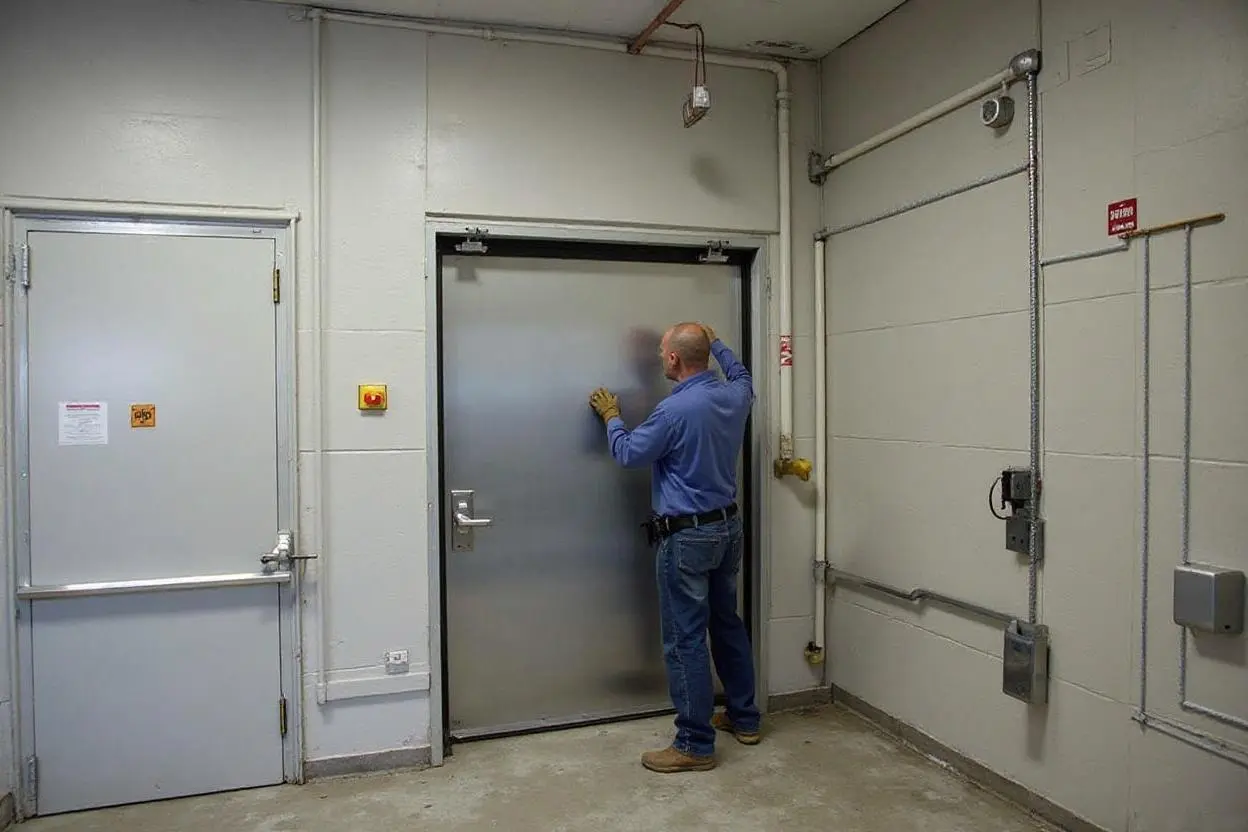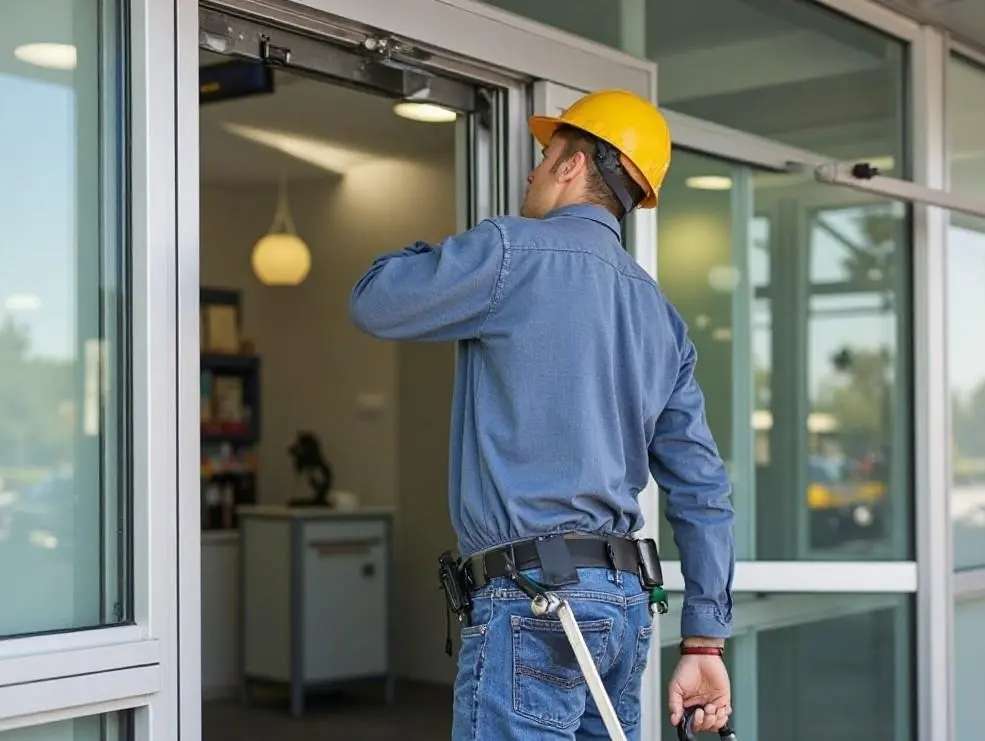Automatic doors work hard in Buffalo. Lake-effect snow, salt, and freeze-thaw cycles create wear that shops in warmer cities never see. A clean, well-tuned automatic door keeps customers moving, keeps heat inside, and meets safety codes. The right maintenance schedule prevents breakdowns on the coldest day of the year and extends system life by years.
Weather in Buffalo changes the maintenance math
Cold snaps thicken lubricants and slow operators. Salt tracks into thresholds and corrodes hardware. Snowmelt seeps into sensors and then refreezes overnight. Doors that cycle thousands of times a week at a grocery entrance face a different level of strain than a side vestibule at a medical office. Local conditions drive frequency more than the calendar does.
A-24 Hour Door National Inc. services automatic doors across Erie County. The team sees the same pattern each winter: minor neglect in fall turns into stuck doors, false openings, and noisy operators by January. A simple quarterly plan avoids most of those calls.
Baseline schedule that works in Western New York
For most commercial sites in Buffalo, quarterly professional service is the safe baseline. That means one visit every three months, with extra attention before and after winter. High-traffic entrances benefit from monthly quick checks during December through March. Light-traffic or interior-only doors can often hold at semiannual timing, provided an annual safety inspection still happens.
Here is a simple rule of thumb that reflects real usage around Buffalo:
- High traffic (grocery, hospitals, transit, big-box retail): quarterly service year-round, with brief monthly winter checks. Moderate traffic (banks, pharmacies, clinics, office lobbies): quarterly service, plus a pre-winter tune-up in October or early November. Low traffic (staff entrances, interior corridors, storage areas): service every six months, plus an annual safety check with recorded thresholds and signage review.
What “automatic door maintenance” actually covers
A proper visit is more than a quick wipe-down. A trained technician checks sensors, measures closing forces, and confirms the door opens and closes within ANSI/BHMA A156.10 or A156.19 standards for swinging, sliding, or low-energy operators. They verify presence detection, hold-open times, approach sensor angles, and safety signage. They inspect rollers, tracks, pivot points, belts, and gearboxes. They clean thresholds, tighten fasteners, and test the backup settings after a power cycle. They also log the findings, which helps with liability if an incident occurs.
Salt control is a Buffalo-specific task. Thresholds and bottom rails trap grit that chews through rollers and seals. A winter service should include detailed cleaning under cover plates and at floor guides.
Signs you should call earlier than scheduled
Most breakdowns start with small symptoms. Catch them fast and the repair is minor; ignore them and the door fails on a holiday weekend.
- Hesitation on opening or slow close compared to normal operation. Chirping, grinding, or a new hum from the header or operator. Door bounces back open or fails to fully close on the first try. Approach sensors false-trigger from snow piles, wet mats, or reflections. Visible belt fray, damaged rollers, loose guide rail, or scuffed tracks.
If any of these appear, an inspection now costs less than an emergency later.
Safety and compliance are part of the clock
Automatic doors are life-safety devices. Annual safety checks are expected under industry standards and many insurance policies. In practice, that means at least once per year a qualified technician documents opening speeds, closing forces, sensor coverage, manual breakout function (for sliding doors), and proper decals. For medical facilities, semiannual safety verification is common. Retailers with heavy customer flow often align these checks with seasonal resets.
Winterization for Buffalo addresses
A pre-winter visit in October or early November pays for itself. Technicians replace brittle weatherstripping, verify heater elements in vestibules work, adjust hold-open times for heavier foot traffic with coats and carts, and confirm sensors read correctly off darker, wet clothing. They also re-angle sensors to avoid false trips from drifting snow at the curb and add protective covers where wind drives sleet at the header.
After the last deep freeze, a spring service helps. It clears salt residue, checks corrosion on fasteners, re-lubricates moving parts with the right-grade lubricants, and resets sensors for brighter, dry conditions.
How usage affects the interval
Not all door cycles are equal. A hospital entrance might see 6,000 to 12,000 cycles per day. A suburban bank may see 800 to 1,500. Higher cycles accelerate belt wear and sensor drift. Doors near cafés and food courts pick up sugar residue that gums tracks. Locations with carts, gurneys, or strollers need tighter tolerances on presence detection, which drift faster in winter.
If your door serves more than 50,000 cycles per week, aim for quarterly service with mid-cycle checks in peak season. If fewer than 10,000, semiannual may suffice with annual safety documentation.

Cost versus downtime
Unplanned outages cost more than the repair. A stuck sliding door at a grocery store forces staff to post a spotter, prop doors in freezing air, and lose heat. Heating loss through a stuck-open pair can reach hundreds of dollars in one day during a cold snap. A quarterly plan with A-24 Hour Door National Inc. typically reduces emergency calls by 40 to 60 percent compared to reactive service, based on local client histories. Parts last longer when kept clean and correctly aligned.
Quick owner checks between visits
Daily or weekly light checks help catch issues. Keep it simple and consistent.
- Inspect and clear the threshold and floor guide of salt, pebbles, and debris. Watch a few open-close cycles at busy times and listen for new noises. Confirm required safety decals are present and visible. Make sure mats do not creep into sensor zones. Test breakout function on sliding doors with staff training, then reset.
If anything looks off, schedule a service call. Do not adjust internal pots or settings without training; minor misadjustments can disable safety coverage.
What to ask your service provider
Experience with Buffalo weather matters. Ask for a maintenance plan that names tasks by season. Request documentation: sensor coverage photos or diagrams, force measurements, and part condition notes. Clarify response times for no-heat days or storefront damage. Confirm the technician carries common parts for your brand — BEA sensors, NABCO, Horton, Stanley, Record, or dormakaba components — to avoid multiple trips.

Recommended cadence by door type
Sliding doors at retail and healthcare sites usually need quarterly service due to higher cycle counts and critical safety edges. Low-energy swing operators at offices often do well on a semiannual plan, with an extra winter check if the door opens to the outside. Revolving doors require quarterly lubrication and alignment, plus an annual speed governor test. Mixed vestibules benefit from a synchronized plan so inner and outer doors work together under winter loads.
Why choose a local team
A-24 Hour Door National Inc. works across Buffalo, Cheektowaga, Amherst, Tonawanda, Lackawanna, West Seneca, and Orchard Park. The technicians see the same salt patterns, wind tunnels, and slush lines that show up automatic doors every January along Delaware Avenue and Niagara Street. That local pattern recognition speeds diagnosis. The team stocks cold-rated lubricants and common winter-failure parts on the truck during storm weeks, which keeps first-visit fix rates high.
Put a schedule on the calendar now
For most businesses in Buffalo, NY, the answer is clear: plan quarterly automatic door maintenance, with a fall winterization and a spring reset. Light-use interior doors can stretch to twice a year if an annual safety inspection is logged. High-traffic sites should add brief winter checks. This rhythm reduces breakdowns, saves heat, and keeps entrances safe.
If an entrance is slowing, buzzing, or catching, or if winter is approaching, book a service visit. A-24 Hour Door National Inc. can set up a maintenance plan that fits traffic, location, and door type — and keep your doors working smoothly through Buffalo weather. Schedule a visit today to secure your spot before the next cold snap.
A-24 Hour Door National Inc provides commercial and residential door repair in Buffalo, NY. Our technicians service and replace a wide range of entry systems, including automatic business doors, hollow metal frames, storefront entrances, fire-rated steel and wood doors, and both sectional and rolling steel garage doors. We’re available 24/7, including holidays, to deliver emergency repairs and keep your property secure. Our service trucks arrive fully stocked with hardware, tools, and replacement parts to minimize downtime and restore safe, reliable access. Whether you need a new door installed or fast repair to get your business back up and running, our team is ready to help.
A-24 Hour Door National Inc
344 Sycamore St
Buffalo,
NY
14204,
USA
Phone: (716) 894-2000
Website: https://a24hour.biz/buffalo
Instagram: @a24hourdoor
Facebook: 24 Hour Door
Yelp: A-24 Hour Door National (Buffalo)
X (Twitter): @a24hrdoor